Operations and Project Management: Rolls Royce Case Study Report
VerifiedAdded on 2023/01/19
|22
|6335
|28
Report
AI Summary
This report provides a detailed analysis of operations and project management, utilizing Rolls Royce as a case study for operations management principles and Portakabin for project life cycle implementation. The first part of the report critically examines Rolls Royce's operations, including Taylor's scientific management, flexible specialization, mass customization, and agile manufacturing. It evaluates the extent to which Rolls Royce's operations management meets its requirements, such as cost, quality, and safety, and explores continuous improvement philosophies and lean principles. The second part focuses on the project life cycle, analyzing different theories, concepts, and models used in large and small-scale projects. The report emphasizes critical analysis and provides recommendations based on the findings, offering insights into effective operations and project management strategies.
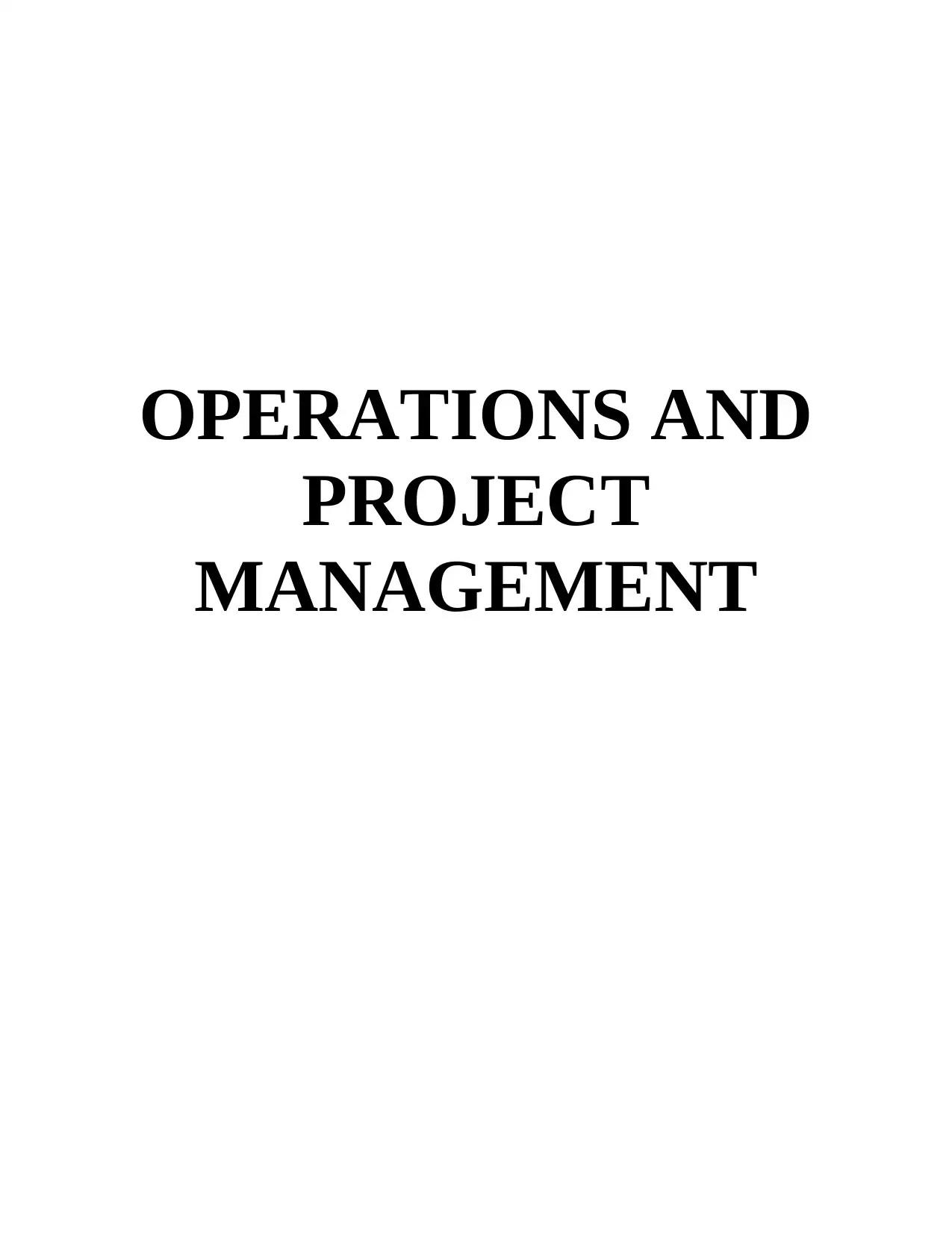
OPERATIONS AND
PROJECT
MANAGEMENT
PROJECT
MANAGEMENT
Paraphrase This Document
Need a fresh take? Get an instant paraphrase of this document with our AI Paraphraser
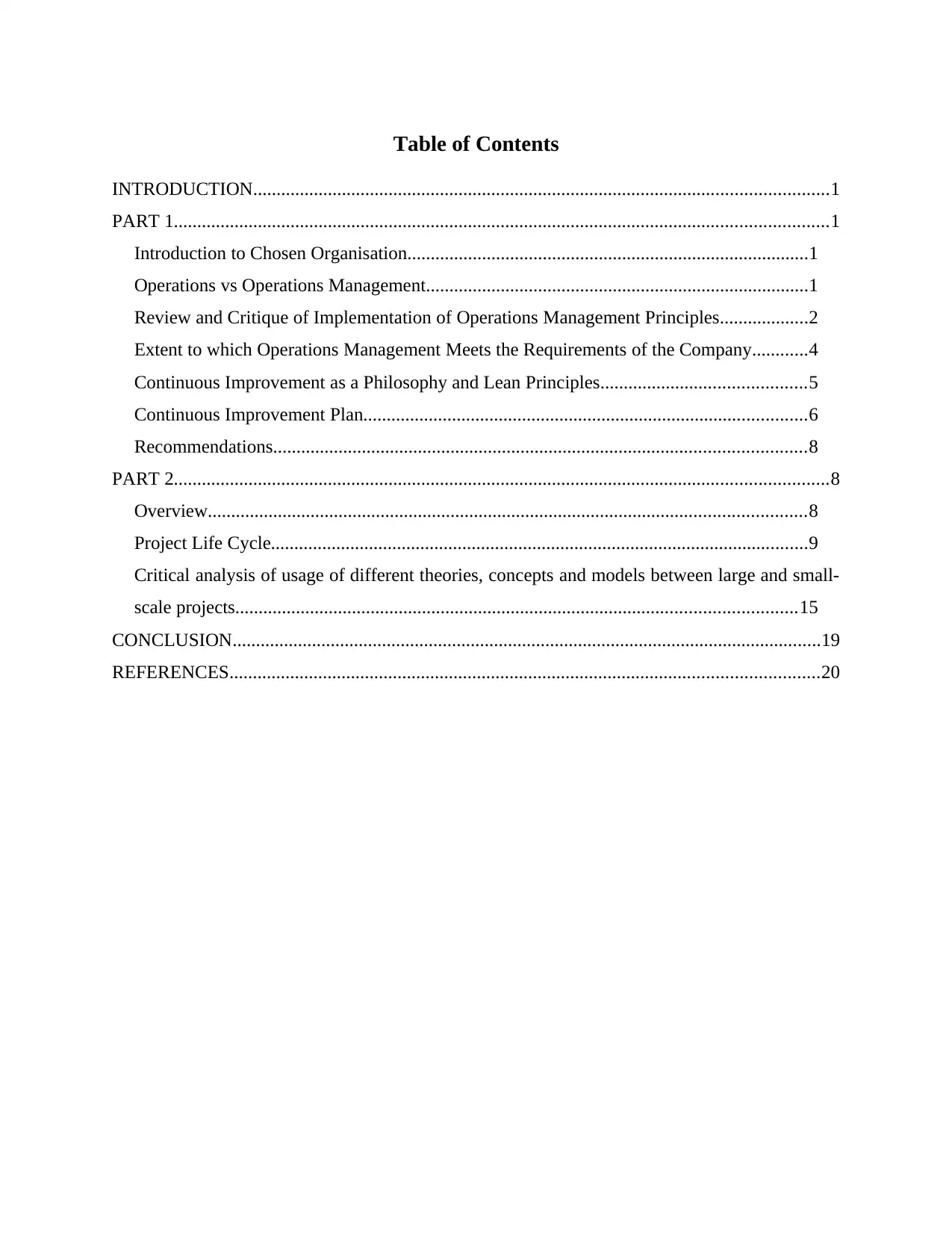
Table of Contents
INTRODUCTION...........................................................................................................................1
PART 1............................................................................................................................................1
Introduction to Chosen Organisation......................................................................................1
Operations vs Operations Management..................................................................................1
Review and Critique of Implementation of Operations Management Principles...................2
Extent to which Operations Management Meets the Requirements of the Company............4
Continuous Improvement as a Philosophy and Lean Principles............................................5
Continuous Improvement Plan...............................................................................................6
Recommendations..................................................................................................................8
PART 2............................................................................................................................................8
Overview................................................................................................................................8
Project Life Cycle...................................................................................................................9
Critical analysis of usage of different theories, concepts and models between large and small-
scale projects........................................................................................................................15
CONCLUSION..............................................................................................................................19
REFERENCES..............................................................................................................................20
INTRODUCTION...........................................................................................................................1
PART 1............................................................................................................................................1
Introduction to Chosen Organisation......................................................................................1
Operations vs Operations Management..................................................................................1
Review and Critique of Implementation of Operations Management Principles...................2
Extent to which Operations Management Meets the Requirements of the Company............4
Continuous Improvement as a Philosophy and Lean Principles............................................5
Continuous Improvement Plan...............................................................................................6
Recommendations..................................................................................................................8
PART 2............................................................................................................................................8
Overview................................................................................................................................8
Project Life Cycle...................................................................................................................9
Critical analysis of usage of different theories, concepts and models between large and small-
scale projects........................................................................................................................15
CONCLUSION..............................................................................................................................19
REFERENCES..............................................................................................................................20
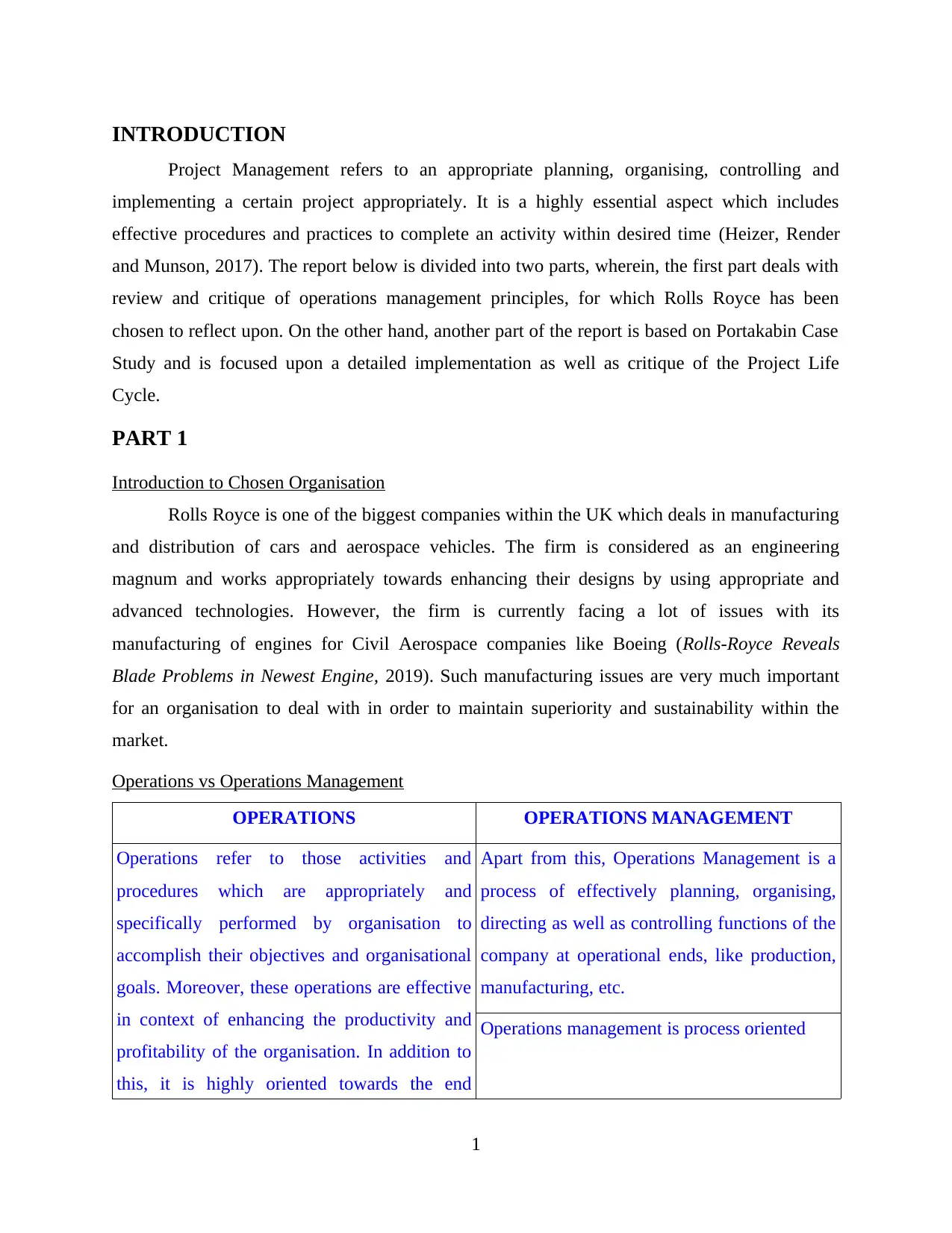
INTRODUCTION
Project Management refers to an appropriate planning, organising, controlling and
implementing a certain project appropriately. It is a highly essential aspect which includes
effective procedures and practices to complete an activity within desired time (Heizer, Render
and Munson, 2017). The report below is divided into two parts, wherein, the first part deals with
review and critique of operations management principles, for which Rolls Royce has been
chosen to reflect upon. On the other hand, another part of the report is based on Portakabin Case
Study and is focused upon a detailed implementation as well as critique of the Project Life
Cycle.
PART 1
Introduction to Chosen Organisation
Rolls Royce is one of the biggest companies within the UK which deals in manufacturing
and distribution of cars and aerospace vehicles. The firm is considered as an engineering
magnum and works appropriately towards enhancing their designs by using appropriate and
advanced technologies. However, the firm is currently facing a lot of issues with its
manufacturing of engines for Civil Aerospace companies like Boeing (Rolls-Royce Reveals
Blade Problems in Newest Engine, 2019). Such manufacturing issues are very much important
for an organisation to deal with in order to maintain superiority and sustainability within the
market.
Operations vs Operations Management
OPERATIONS OPERATIONS MANAGEMENT
Operations refer to those activities and
procedures which are appropriately and
specifically performed by organisation to
accomplish their objectives and organisational
goals. Moreover, these operations are effective
in context of enhancing the productivity and
profitability of the organisation. In addition to
this, it is highly oriented towards the end
Apart from this, Operations Management is a
process of effectively planning, organising,
directing as well as controlling functions of the
company at operational ends, like production,
manufacturing, etc.
Operations management is process oriented
1
Project Management refers to an appropriate planning, organising, controlling and
implementing a certain project appropriately. It is a highly essential aspect which includes
effective procedures and practices to complete an activity within desired time (Heizer, Render
and Munson, 2017). The report below is divided into two parts, wherein, the first part deals with
review and critique of operations management principles, for which Rolls Royce has been
chosen to reflect upon. On the other hand, another part of the report is based on Portakabin Case
Study and is focused upon a detailed implementation as well as critique of the Project Life
Cycle.
PART 1
Introduction to Chosen Organisation
Rolls Royce is one of the biggest companies within the UK which deals in manufacturing
and distribution of cars and aerospace vehicles. The firm is considered as an engineering
magnum and works appropriately towards enhancing their designs by using appropriate and
advanced technologies. However, the firm is currently facing a lot of issues with its
manufacturing of engines for Civil Aerospace companies like Boeing (Rolls-Royce Reveals
Blade Problems in Newest Engine, 2019). Such manufacturing issues are very much important
for an organisation to deal with in order to maintain superiority and sustainability within the
market.
Operations vs Operations Management
OPERATIONS OPERATIONS MANAGEMENT
Operations refer to those activities and
procedures which are appropriately and
specifically performed by organisation to
accomplish their objectives and organisational
goals. Moreover, these operations are effective
in context of enhancing the productivity and
profitability of the organisation. In addition to
this, it is highly oriented towards the end
Apart from this, Operations Management is a
process of effectively planning, organising,
directing as well as controlling functions of the
company at operational ends, like production,
manufacturing, etc.
Operations management is process oriented
1
⊘ This is a preview!⊘
Do you want full access?
Subscribe today to unlock all pages.

Trusted by 1+ million students worldwide
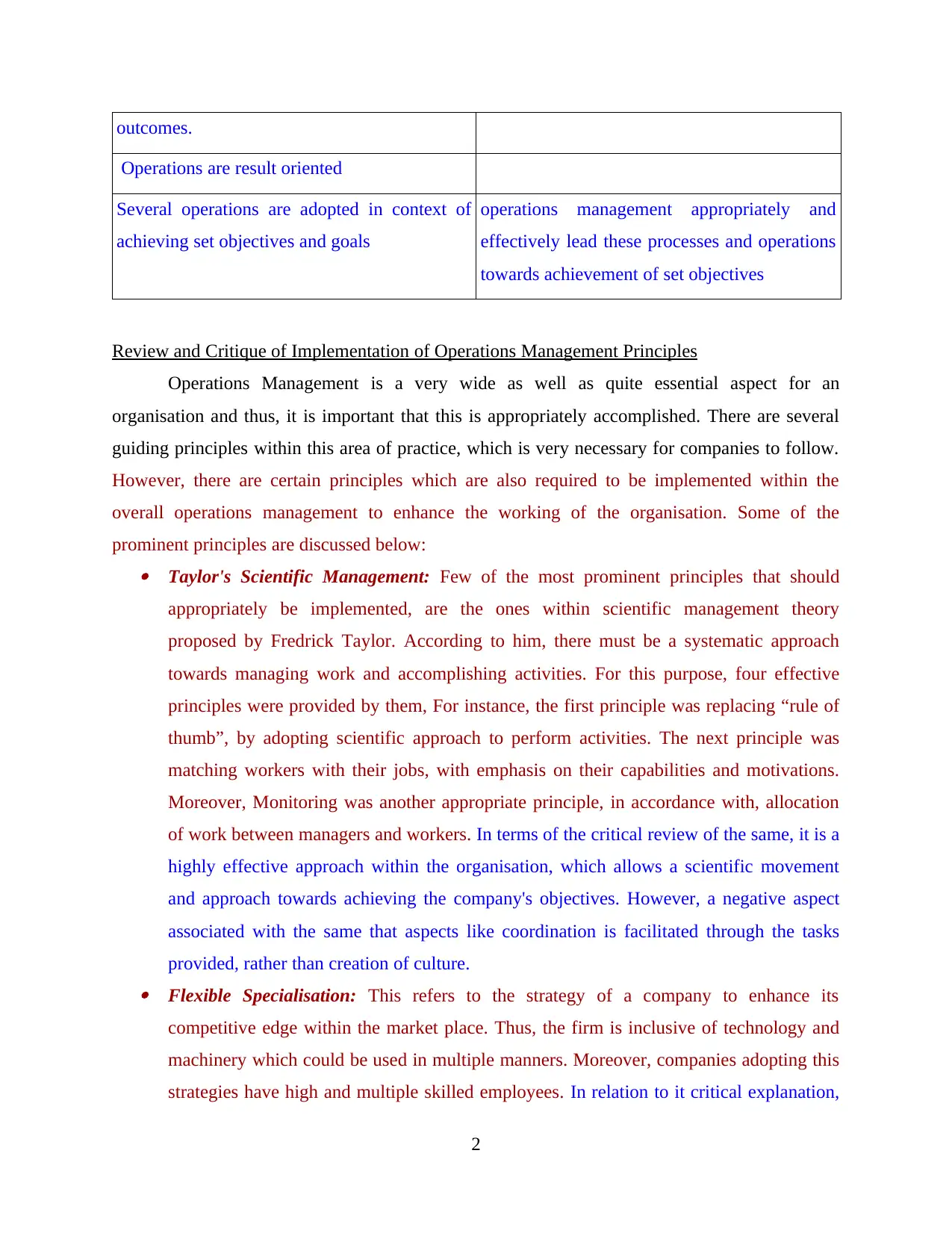
outcomes.
Operations are result oriented
Several operations are adopted in context of
achieving set objectives and goals
operations management appropriately and
effectively lead these processes and operations
towards achievement of set objectives
Review and Critique of Implementation of Operations Management Principles
Operations Management is a very wide as well as quite essential aspect for an
organisation and thus, it is important that this is appropriately accomplished. There are several
guiding principles within this area of practice, which is very necessary for companies to follow.
However, there are certain principles which are also required to be implemented within the
overall operations management to enhance the working of the organisation. Some of the
prominent principles are discussed below: Taylor's Scientific Management: Few of the most prominent principles that should
appropriately be implemented, are the ones within scientific management theory
proposed by Fredrick Taylor. According to him, there must be a systematic approach
towards managing work and accomplishing activities. For this purpose, four effective
principles were provided by them, For instance, the first principle was replacing “rule of
thumb”, by adopting scientific approach to perform activities. The next principle was
matching workers with their jobs, with emphasis on their capabilities and motivations.
Moreover, Monitoring was another appropriate principle, in accordance with, allocation
of work between managers and workers. In terms of the critical review of the same, it is a
highly effective approach within the organisation, which allows a scientific movement
and approach towards achieving the company's objectives. However, a negative aspect
associated with the same that aspects like coordination is facilitated through the tasks
provided, rather than creation of culture. Flexible Specialisation: This refers to the strategy of a company to enhance its
competitive edge within the market place. Thus, the firm is inclusive of technology and
machinery which could be used in multiple manners. Moreover, companies adopting this
strategies have high and multiple skilled employees. In relation to it critical explanation,
2
Operations are result oriented
Several operations are adopted in context of
achieving set objectives and goals
operations management appropriately and
effectively lead these processes and operations
towards achievement of set objectives
Review and Critique of Implementation of Operations Management Principles
Operations Management is a very wide as well as quite essential aspect for an
organisation and thus, it is important that this is appropriately accomplished. There are several
guiding principles within this area of practice, which is very necessary for companies to follow.
However, there are certain principles which are also required to be implemented within the
overall operations management to enhance the working of the organisation. Some of the
prominent principles are discussed below: Taylor's Scientific Management: Few of the most prominent principles that should
appropriately be implemented, are the ones within scientific management theory
proposed by Fredrick Taylor. According to him, there must be a systematic approach
towards managing work and accomplishing activities. For this purpose, four effective
principles were provided by them, For instance, the first principle was replacing “rule of
thumb”, by adopting scientific approach to perform activities. The next principle was
matching workers with their jobs, with emphasis on their capabilities and motivations.
Moreover, Monitoring was another appropriate principle, in accordance with, allocation
of work between managers and workers. In terms of the critical review of the same, it is a
highly effective approach within the organisation, which allows a scientific movement
and approach towards achieving the company's objectives. However, a negative aspect
associated with the same that aspects like coordination is facilitated through the tasks
provided, rather than creation of culture. Flexible Specialisation: This refers to the strategy of a company to enhance its
competitive edge within the market place. Thus, the firm is inclusive of technology and
machinery which could be used in multiple manners. Moreover, companies adopting this
strategies have high and multiple skilled employees. In relation to it critical explanation,
2
Paraphrase This Document
Need a fresh take? Get an instant paraphrase of this document with our AI Paraphraser
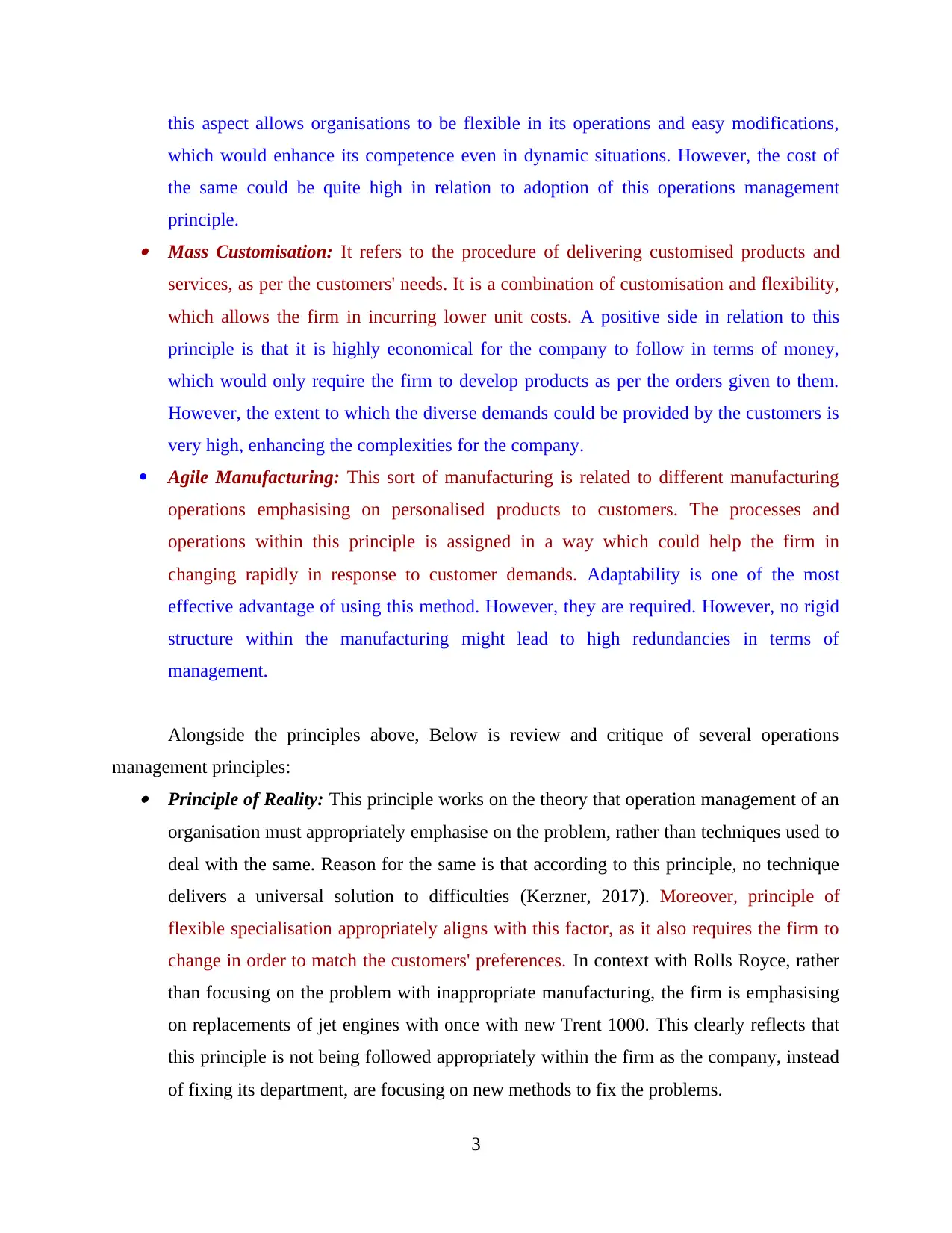
this aspect allows organisations to be flexible in its operations and easy modifications,
which would enhance its competence even in dynamic situations. However, the cost of
the same could be quite high in relation to adoption of this operations management
principle. Mass Customisation: It refers to the procedure of delivering customised products and
services, as per the customers' needs. It is a combination of customisation and flexibility,
which allows the firm in incurring lower unit costs. A positive side in relation to this
principle is that it is highly economical for the company to follow in terms of money,
which would only require the firm to develop products as per the orders given to them.
However, the extent to which the diverse demands could be provided by the customers is
very high, enhancing the complexities for the company.
Agile Manufacturing: This sort of manufacturing is related to different manufacturing
operations emphasising on personalised products to customers. The processes and
operations within this principle is assigned in a way which could help the firm in
changing rapidly in response to customer demands. Adaptability is one of the most
effective advantage of using this method. However, they are required. However, no rigid
structure within the manufacturing might lead to high redundancies in terms of
management.
Alongside the principles above, Below is review and critique of several operations
management principles: Principle of Reality: This principle works on the theory that operation management of an
organisation must appropriately emphasise on the problem, rather than techniques used to
deal with the same. Reason for the same is that according to this principle, no technique
delivers a universal solution to difficulties (Kerzner, 2017). Moreover, principle of
flexible specialisation appropriately aligns with this factor, as it also requires the firm to
change in order to match the customers' preferences. In context with Rolls Royce, rather
than focusing on the problem with inappropriate manufacturing, the firm is emphasising
on replacements of jet engines with once with new Trent 1000. This clearly reflects that
this principle is not being followed appropriately within the firm as the company, instead
of fixing its department, are focusing on new methods to fix the problems.
3
which would enhance its competence even in dynamic situations. However, the cost of
the same could be quite high in relation to adoption of this operations management
principle. Mass Customisation: It refers to the procedure of delivering customised products and
services, as per the customers' needs. It is a combination of customisation and flexibility,
which allows the firm in incurring lower unit costs. A positive side in relation to this
principle is that it is highly economical for the company to follow in terms of money,
which would only require the firm to develop products as per the orders given to them.
However, the extent to which the diverse demands could be provided by the customers is
very high, enhancing the complexities for the company.
Agile Manufacturing: This sort of manufacturing is related to different manufacturing
operations emphasising on personalised products to customers. The processes and
operations within this principle is assigned in a way which could help the firm in
changing rapidly in response to customer demands. Adaptability is one of the most
effective advantage of using this method. However, they are required. However, no rigid
structure within the manufacturing might lead to high redundancies in terms of
management.
Alongside the principles above, Below is review and critique of several operations
management principles: Principle of Reality: This principle works on the theory that operation management of an
organisation must appropriately emphasise on the problem, rather than techniques used to
deal with the same. Reason for the same is that according to this principle, no technique
delivers a universal solution to difficulties (Kerzner, 2017). Moreover, principle of
flexible specialisation appropriately aligns with this factor, as it also requires the firm to
change in order to match the customers' preferences. In context with Rolls Royce, rather
than focusing on the problem with inappropriate manufacturing, the firm is emphasising
on replacements of jet engines with once with new Trent 1000. This clearly reflects that
this principle is not being followed appropriately within the firm as the company, instead
of fixing its department, are focusing on new methods to fix the problems.
3
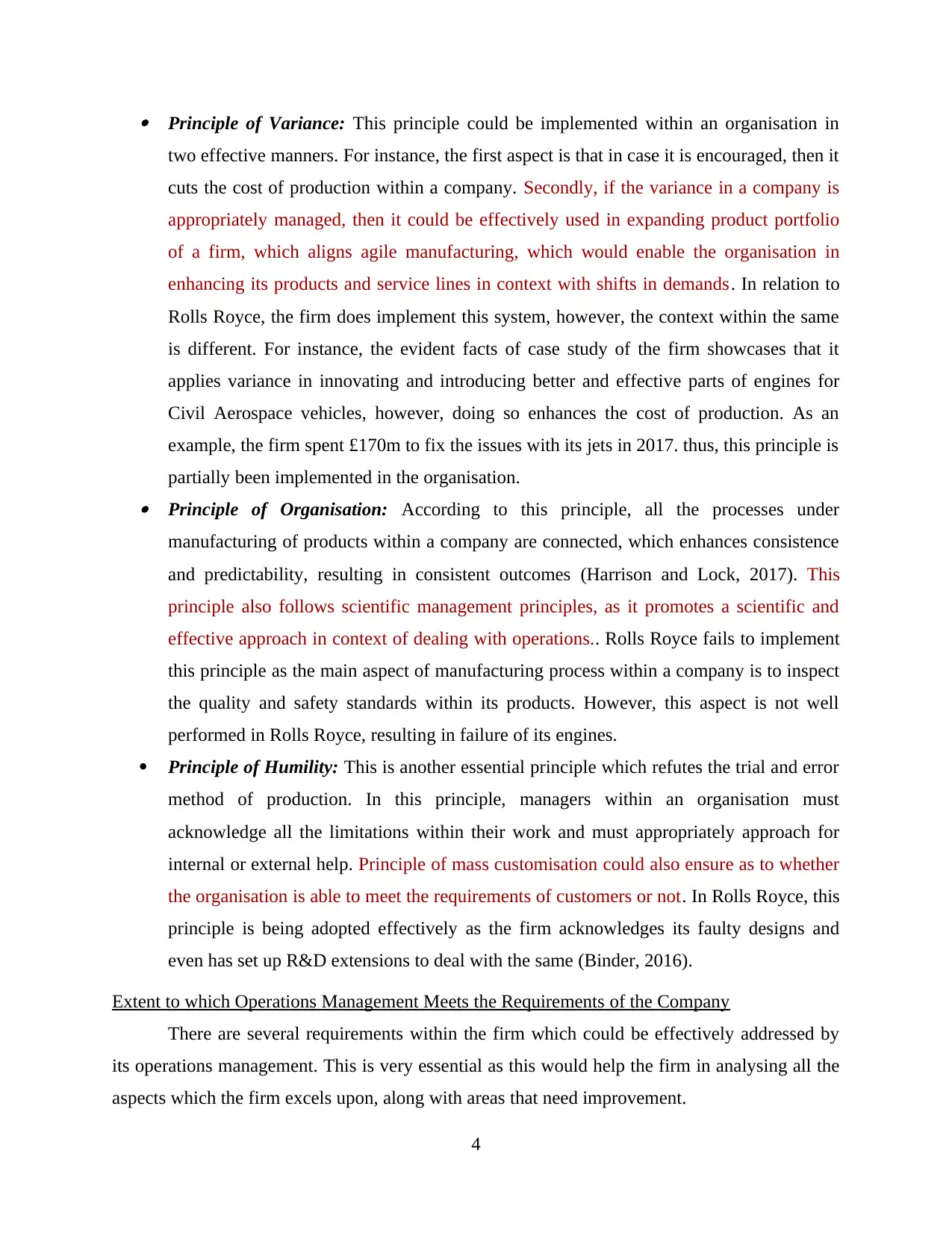
Principle of Variance: This principle could be implemented within an organisation in
two effective manners. For instance, the first aspect is that in case it is encouraged, then it
cuts the cost of production within a company. Secondly, if the variance in a company is
appropriately managed, then it could be effectively used in expanding product portfolio
of a firm, which aligns agile manufacturing, which would enable the organisation in
enhancing its products and service lines in context with shifts in demands. In relation to
Rolls Royce, the firm does implement this system, however, the context within the same
is different. For instance, the evident facts of case study of the firm showcases that it
applies variance in innovating and introducing better and effective parts of engines for
Civil Aerospace vehicles, however, doing so enhances the cost of production. As an
example, the firm spent £170m to fix the issues with its jets in 2017. thus, this principle is
partially been implemented in the organisation. Principle of Organisation: According to this principle, all the processes under
manufacturing of products within a company are connected, which enhances consistence
and predictability, resulting in consistent outcomes (Harrison and Lock, 2017). This
principle also follows scientific management principles, as it promotes a scientific and
effective approach in context of dealing with operations.. Rolls Royce fails to implement
this principle as the main aspect of manufacturing process within a company is to inspect
the quality and safety standards within its products. However, this aspect is not well
performed in Rolls Royce, resulting in failure of its engines.
Principle of Humility: This is another essential principle which refutes the trial and error
method of production. In this principle, managers within an organisation must
acknowledge all the limitations within their work and must appropriately approach for
internal or external help. Principle of mass customisation could also ensure as to whether
the organisation is able to meet the requirements of customers or not. In Rolls Royce, this
principle is being adopted effectively as the firm acknowledges its faulty designs and
even has set up R&D extensions to deal with the same (Binder, 2016).
Extent to which Operations Management Meets the Requirements of the Company
There are several requirements within the firm which could be effectively addressed by
its operations management. This is very essential as this would help the firm in analysing all the
aspects which the firm excels upon, along with areas that need improvement.
4
two effective manners. For instance, the first aspect is that in case it is encouraged, then it
cuts the cost of production within a company. Secondly, if the variance in a company is
appropriately managed, then it could be effectively used in expanding product portfolio
of a firm, which aligns agile manufacturing, which would enable the organisation in
enhancing its products and service lines in context with shifts in demands. In relation to
Rolls Royce, the firm does implement this system, however, the context within the same
is different. For instance, the evident facts of case study of the firm showcases that it
applies variance in innovating and introducing better and effective parts of engines for
Civil Aerospace vehicles, however, doing so enhances the cost of production. As an
example, the firm spent £170m to fix the issues with its jets in 2017. thus, this principle is
partially been implemented in the organisation. Principle of Organisation: According to this principle, all the processes under
manufacturing of products within a company are connected, which enhances consistence
and predictability, resulting in consistent outcomes (Harrison and Lock, 2017). This
principle also follows scientific management principles, as it promotes a scientific and
effective approach in context of dealing with operations.. Rolls Royce fails to implement
this principle as the main aspect of manufacturing process within a company is to inspect
the quality and safety standards within its products. However, this aspect is not well
performed in Rolls Royce, resulting in failure of its engines.
Principle of Humility: This is another essential principle which refutes the trial and error
method of production. In this principle, managers within an organisation must
acknowledge all the limitations within their work and must appropriately approach for
internal or external help. Principle of mass customisation could also ensure as to whether
the organisation is able to meet the requirements of customers or not. In Rolls Royce, this
principle is being adopted effectively as the firm acknowledges its faulty designs and
even has set up R&D extensions to deal with the same (Binder, 2016).
Extent to which Operations Management Meets the Requirements of the Company
There are several requirements within the firm which could be effectively addressed by
its operations management. This is very essential as this would help the firm in analysing all the
aspects which the firm excels upon, along with areas that need improvement.
4
⊘ This is a preview!⊘
Do you want full access?
Subscribe today to unlock all pages.

Trusted by 1+ million students worldwide
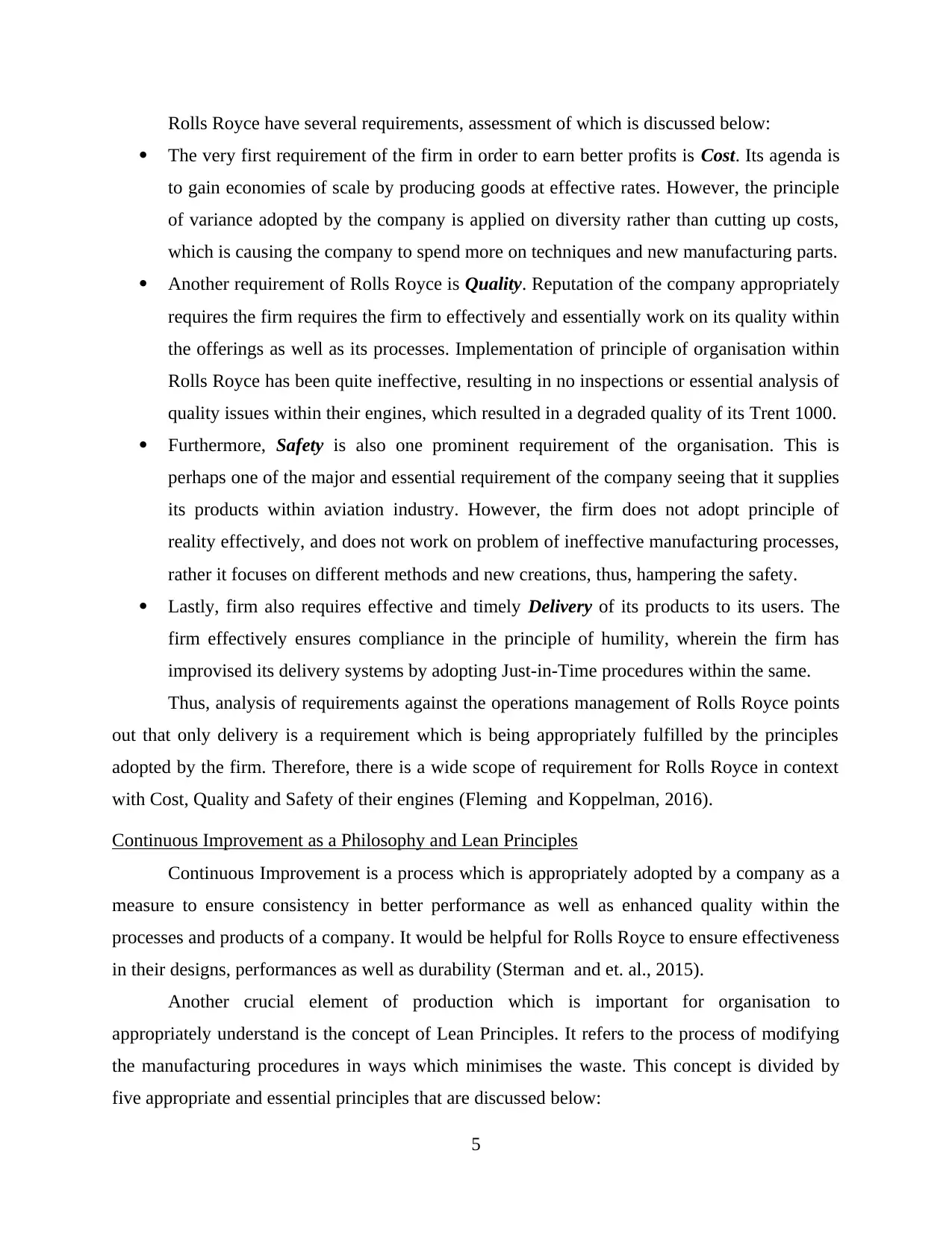
Rolls Royce have several requirements, assessment of which is discussed below:
The very first requirement of the firm in order to earn better profits is Cost. Its agenda is
to gain economies of scale by producing goods at effective rates. However, the principle
of variance adopted by the company is applied on diversity rather than cutting up costs,
which is causing the company to spend more on techniques and new manufacturing parts.
Another requirement of Rolls Royce is Quality. Reputation of the company appropriately
requires the firm requires the firm to effectively and essentially work on its quality within
the offerings as well as its processes. Implementation of principle of organisation within
Rolls Royce has been quite ineffective, resulting in no inspections or essential analysis of
quality issues within their engines, which resulted in a degraded quality of its Trent 1000.
Furthermore, Safety is also one prominent requirement of the organisation. This is
perhaps one of the major and essential requirement of the company seeing that it supplies
its products within aviation industry. However, the firm does not adopt principle of
reality effectively, and does not work on problem of ineffective manufacturing processes,
rather it focuses on different methods and new creations, thus, hampering the safety.
Lastly, firm also requires effective and timely Delivery of its products to its users. The
firm effectively ensures compliance in the principle of humility, wherein the firm has
improvised its delivery systems by adopting Just-in-Time procedures within the same.
Thus, analysis of requirements against the operations management of Rolls Royce points
out that only delivery is a requirement which is being appropriately fulfilled by the principles
adopted by the firm. Therefore, there is a wide scope of requirement for Rolls Royce in context
with Cost, Quality and Safety of their engines (Fleming and Koppelman, 2016).
Continuous Improvement as a Philosophy and Lean Principles
Continuous Improvement is a process which is appropriately adopted by a company as a
measure to ensure consistency in better performance as well as enhanced quality within the
processes and products of a company. It would be helpful for Rolls Royce to ensure effectiveness
in their designs, performances as well as durability (Sterman and et. al., 2015).
Another crucial element of production which is important for organisation to
appropriately understand is the concept of Lean Principles. It refers to the process of modifying
the manufacturing procedures in ways which minimises the waste. This concept is divided by
five appropriate and essential principles that are discussed below:
5
The very first requirement of the firm in order to earn better profits is Cost. Its agenda is
to gain economies of scale by producing goods at effective rates. However, the principle
of variance adopted by the company is applied on diversity rather than cutting up costs,
which is causing the company to spend more on techniques and new manufacturing parts.
Another requirement of Rolls Royce is Quality. Reputation of the company appropriately
requires the firm requires the firm to effectively and essentially work on its quality within
the offerings as well as its processes. Implementation of principle of organisation within
Rolls Royce has been quite ineffective, resulting in no inspections or essential analysis of
quality issues within their engines, which resulted in a degraded quality of its Trent 1000.
Furthermore, Safety is also one prominent requirement of the organisation. This is
perhaps one of the major and essential requirement of the company seeing that it supplies
its products within aviation industry. However, the firm does not adopt principle of
reality effectively, and does not work on problem of ineffective manufacturing processes,
rather it focuses on different methods and new creations, thus, hampering the safety.
Lastly, firm also requires effective and timely Delivery of its products to its users. The
firm effectively ensures compliance in the principle of humility, wherein the firm has
improvised its delivery systems by adopting Just-in-Time procedures within the same.
Thus, analysis of requirements against the operations management of Rolls Royce points
out that only delivery is a requirement which is being appropriately fulfilled by the principles
adopted by the firm. Therefore, there is a wide scope of requirement for Rolls Royce in context
with Cost, Quality and Safety of their engines (Fleming and Koppelman, 2016).
Continuous Improvement as a Philosophy and Lean Principles
Continuous Improvement is a process which is appropriately adopted by a company as a
measure to ensure consistency in better performance as well as enhanced quality within the
processes and products of a company. It would be helpful for Rolls Royce to ensure effectiveness
in their designs, performances as well as durability (Sterman and et. al., 2015).
Another crucial element of production which is important for organisation to
appropriately understand is the concept of Lean Principles. It refers to the process of modifying
the manufacturing procedures in ways which minimises the waste. This concept is divided by
five appropriate and essential principles that are discussed below:
5
Paraphrase This Document
Need a fresh take? Get an instant paraphrase of this document with our AI Paraphraser
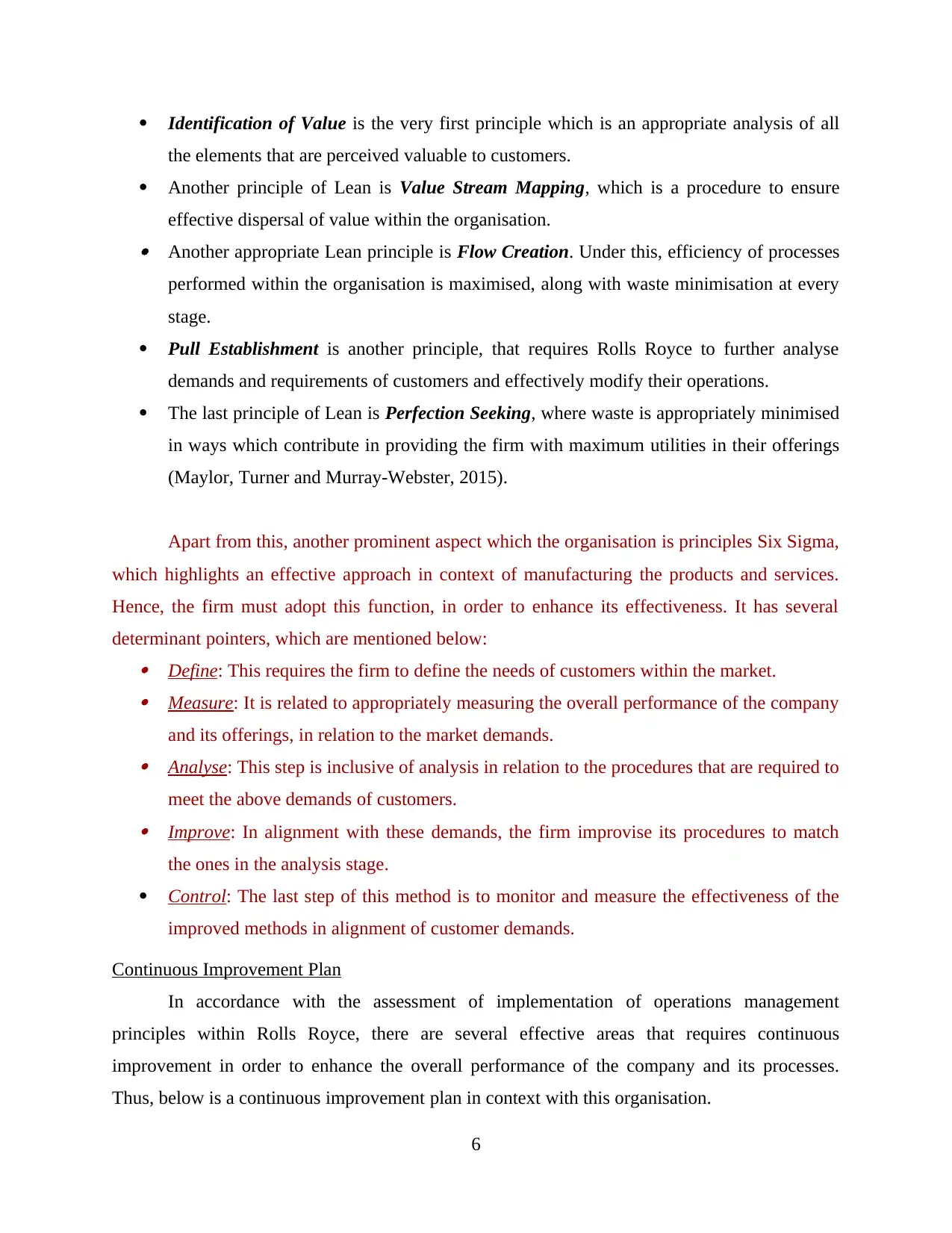
Identification of Value is the very first principle which is an appropriate analysis of all
the elements that are perceived valuable to customers.
Another principle of Lean is Value Stream Mapping, which is a procedure to ensure
effective dispersal of value within the organisation. Another appropriate Lean principle is Flow Creation. Under this, efficiency of processes
performed within the organisation is maximised, along with waste minimisation at every
stage.
Pull Establishment is another principle, that requires Rolls Royce to further analyse
demands and requirements of customers and effectively modify their operations.
The last principle of Lean is Perfection Seeking, where waste is appropriately minimised
in ways which contribute in providing the firm with maximum utilities in their offerings
(Maylor, Turner and Murray-Webster, 2015).
Apart from this, another prominent aspect which the organisation is principles Six Sigma,
which highlights an effective approach in context of manufacturing the products and services.
Hence, the firm must adopt this function, in order to enhance its effectiveness. It has several
determinant pointers, which are mentioned below: Define: This requires the firm to define the needs of customers within the market. Measure: It is related to appropriately measuring the overall performance of the company
and its offerings, in relation to the market demands. Analyse: This step is inclusive of analysis in relation to the procedures that are required to
meet the above demands of customers. Improve: In alignment with these demands, the firm improvise its procedures to match
the ones in the analysis stage.
Control: The last step of this method is to monitor and measure the effectiveness of the
improved methods in alignment of customer demands.
Continuous Improvement Plan
In accordance with the assessment of implementation of operations management
principles within Rolls Royce, there are several effective areas that requires continuous
improvement in order to enhance the overall performance of the company and its processes.
Thus, below is a continuous improvement plan in context with this organisation.
6
the elements that are perceived valuable to customers.
Another principle of Lean is Value Stream Mapping, which is a procedure to ensure
effective dispersal of value within the organisation. Another appropriate Lean principle is Flow Creation. Under this, efficiency of processes
performed within the organisation is maximised, along with waste minimisation at every
stage.
Pull Establishment is another principle, that requires Rolls Royce to further analyse
demands and requirements of customers and effectively modify their operations.
The last principle of Lean is Perfection Seeking, where waste is appropriately minimised
in ways which contribute in providing the firm with maximum utilities in their offerings
(Maylor, Turner and Murray-Webster, 2015).
Apart from this, another prominent aspect which the organisation is principles Six Sigma,
which highlights an effective approach in context of manufacturing the products and services.
Hence, the firm must adopt this function, in order to enhance its effectiveness. It has several
determinant pointers, which are mentioned below: Define: This requires the firm to define the needs of customers within the market. Measure: It is related to appropriately measuring the overall performance of the company
and its offerings, in relation to the market demands. Analyse: This step is inclusive of analysis in relation to the procedures that are required to
meet the above demands of customers. Improve: In alignment with these demands, the firm improvise its procedures to match
the ones in the analysis stage.
Control: The last step of this method is to monitor and measure the effectiveness of the
improved methods in alignment of customer demands.
Continuous Improvement Plan
In accordance with the assessment of implementation of operations management
principles within Rolls Royce, there are several effective areas that requires continuous
improvement in order to enhance the overall performance of the company and its processes.
Thus, below is a continuous improvement plan in context with this organisation.
6
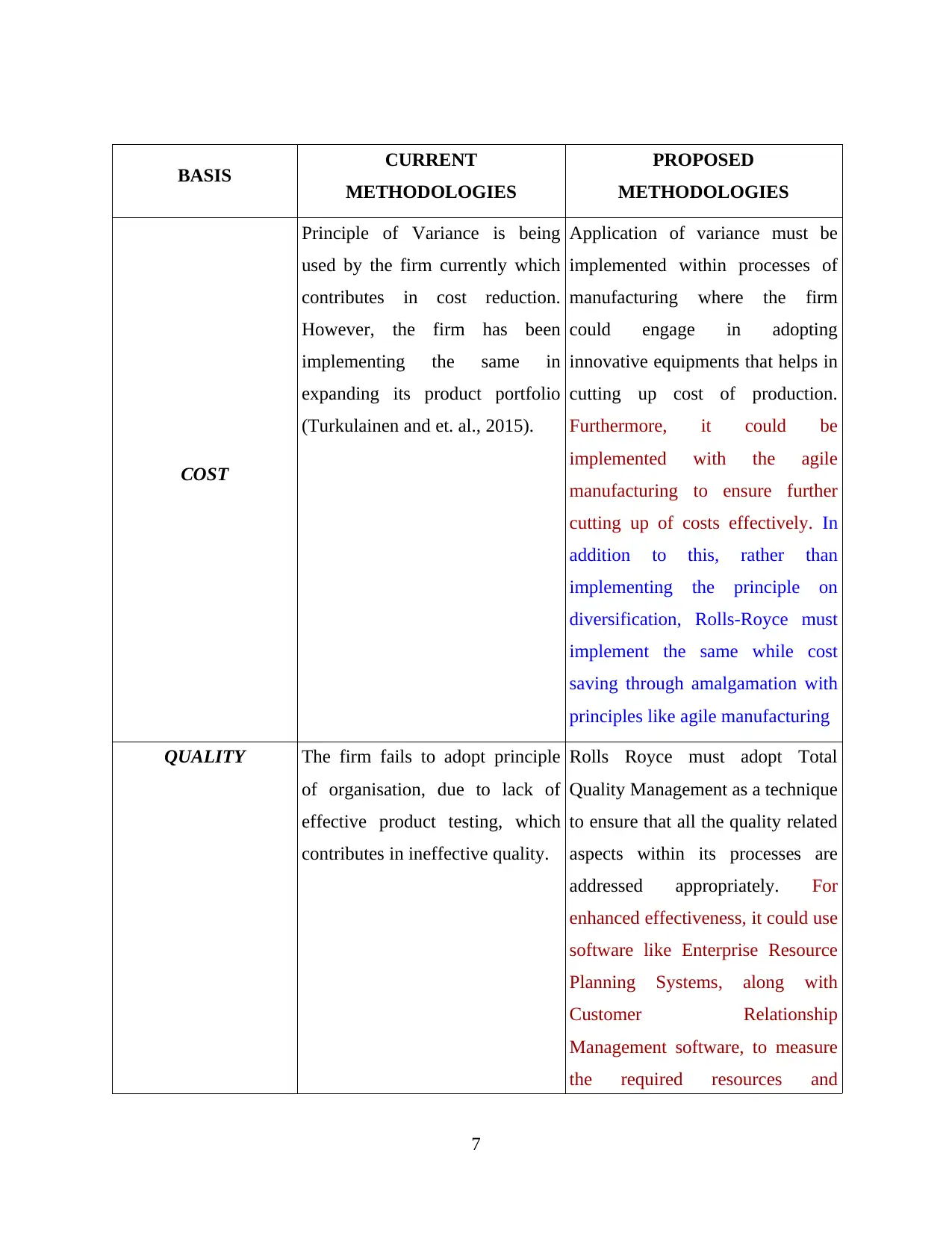
BASIS CURRENT
METHODOLOGIES
PROPOSED
METHODOLOGIES
COST
Principle of Variance is being
used by the firm currently which
contributes in cost reduction.
However, the firm has been
implementing the same in
expanding its product portfolio
(Turkulainen and et. al., 2015).
Application of variance must be
implemented within processes of
manufacturing where the firm
could engage in adopting
innovative equipments that helps in
cutting up cost of production.
Furthermore, it could be
implemented with the agile
manufacturing to ensure further
cutting up of costs effectively. In
addition to this, rather than
implementing the principle on
diversification, Rolls-Royce must
implement the same while cost
saving through amalgamation with
principles like agile manufacturing
QUALITY The firm fails to adopt principle
of organisation, due to lack of
effective product testing, which
contributes in ineffective quality.
Rolls Royce must adopt Total
Quality Management as a technique
to ensure that all the quality related
aspects within its processes are
addressed appropriately. For
enhanced effectiveness, it could use
software like Enterprise Resource
Planning Systems, along with
Customer Relationship
Management software, to measure
the required resources and
7
METHODOLOGIES
PROPOSED
METHODOLOGIES
COST
Principle of Variance is being
used by the firm currently which
contributes in cost reduction.
However, the firm has been
implementing the same in
expanding its product portfolio
(Turkulainen and et. al., 2015).
Application of variance must be
implemented within processes of
manufacturing where the firm
could engage in adopting
innovative equipments that helps in
cutting up cost of production.
Furthermore, it could be
implemented with the agile
manufacturing to ensure further
cutting up of costs effectively. In
addition to this, rather than
implementing the principle on
diversification, Rolls-Royce must
implement the same while cost
saving through amalgamation with
principles like agile manufacturing
QUALITY The firm fails to adopt principle
of organisation, due to lack of
effective product testing, which
contributes in ineffective quality.
Rolls Royce must adopt Total
Quality Management as a technique
to ensure that all the quality related
aspects within its processes are
addressed appropriately. For
enhanced effectiveness, it could use
software like Enterprise Resource
Planning Systems, along with
Customer Relationship
Management software, to measure
the required resources and
7
⊘ This is a preview!⊘
Do you want full access?
Subscribe today to unlock all pages.

Trusted by 1+ million students worldwide
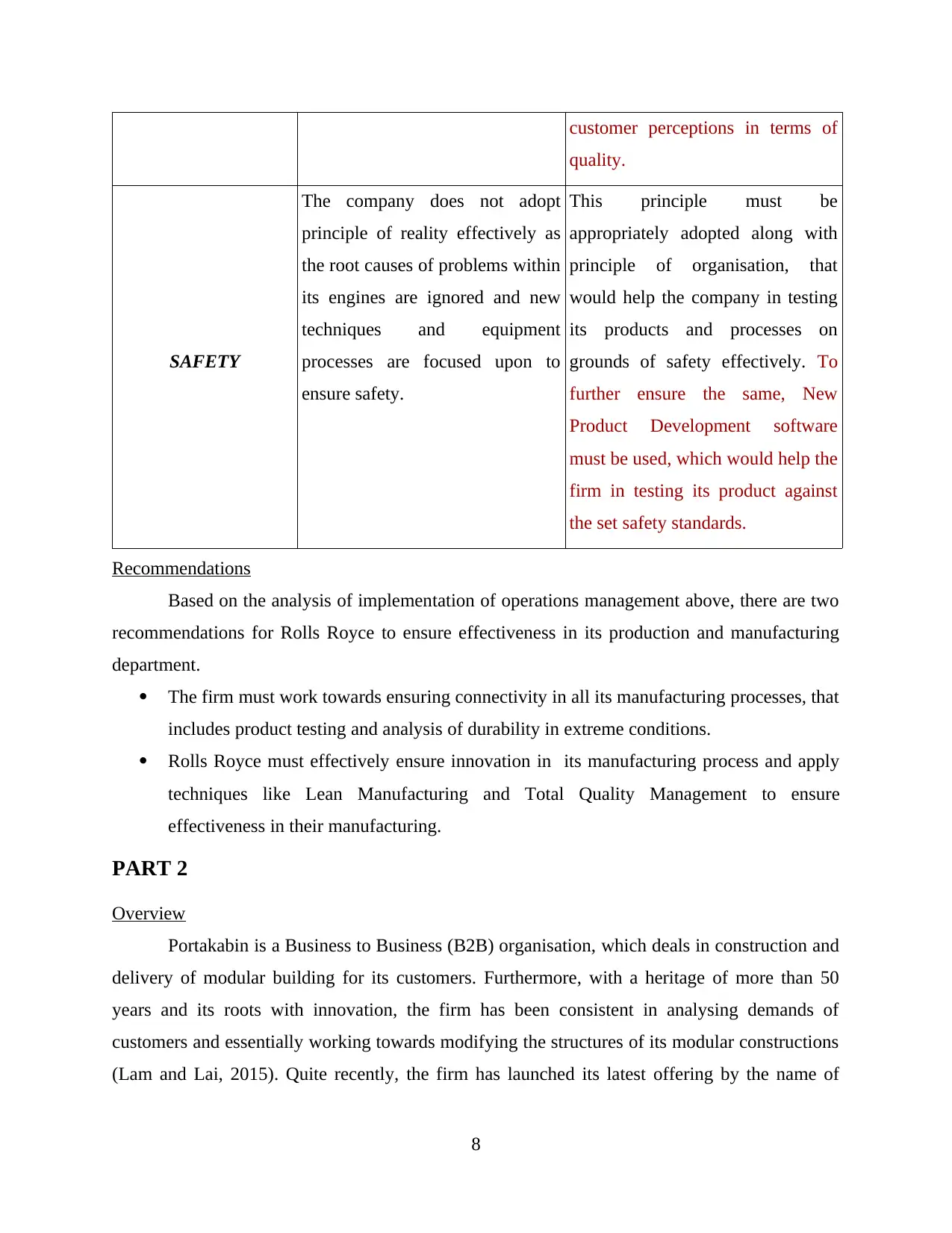
customer perceptions in terms of
quality.
SAFETY
The company does not adopt
principle of reality effectively as
the root causes of problems within
its engines are ignored and new
techniques and equipment
processes are focused upon to
ensure safety.
This principle must be
appropriately adopted along with
principle of organisation, that
would help the company in testing
its products and processes on
grounds of safety effectively. To
further ensure the same, New
Product Development software
must be used, which would help the
firm in testing its product against
the set safety standards.
Recommendations
Based on the analysis of implementation of operations management above, there are two
recommendations for Rolls Royce to ensure effectiveness in its production and manufacturing
department.
The firm must work towards ensuring connectivity in all its manufacturing processes, that
includes product testing and analysis of durability in extreme conditions.
Rolls Royce must effectively ensure innovation in its manufacturing process and apply
techniques like Lean Manufacturing and Total Quality Management to ensure
effectiveness in their manufacturing.
PART 2
Overview
Portakabin is a Business to Business (B2B) organisation, which deals in construction and
delivery of modular building for its customers. Furthermore, with a heritage of more than 50
years and its roots with innovation, the firm has been consistent in analysing demands of
customers and essentially working towards modifying the structures of its modular constructions
(Lam and Lai, 2015). Quite recently, the firm has launched its latest offering by the name of
8
quality.
SAFETY
The company does not adopt
principle of reality effectively as
the root causes of problems within
its engines are ignored and new
techniques and equipment
processes are focused upon to
ensure safety.
This principle must be
appropriately adopted along with
principle of organisation, that
would help the company in testing
its products and processes on
grounds of safety effectively. To
further ensure the same, New
Product Development software
must be used, which would help the
firm in testing its product against
the set safety standards.
Recommendations
Based on the analysis of implementation of operations management above, there are two
recommendations for Rolls Royce to ensure effectiveness in its production and manufacturing
department.
The firm must work towards ensuring connectivity in all its manufacturing processes, that
includes product testing and analysis of durability in extreme conditions.
Rolls Royce must effectively ensure innovation in its manufacturing process and apply
techniques like Lean Manufacturing and Total Quality Management to ensure
effectiveness in their manufacturing.
PART 2
Overview
Portakabin is a Business to Business (B2B) organisation, which deals in construction and
delivery of modular building for its customers. Furthermore, with a heritage of more than 50
years and its roots with innovation, the firm has been consistent in analysing demands of
customers and essentially working towards modifying the structures of its modular constructions
(Lam and Lai, 2015). Quite recently, the firm has launched its latest offering by the name of
8
Paraphrase This Document
Need a fresh take? Get an instant paraphrase of this document with our AI Paraphraser
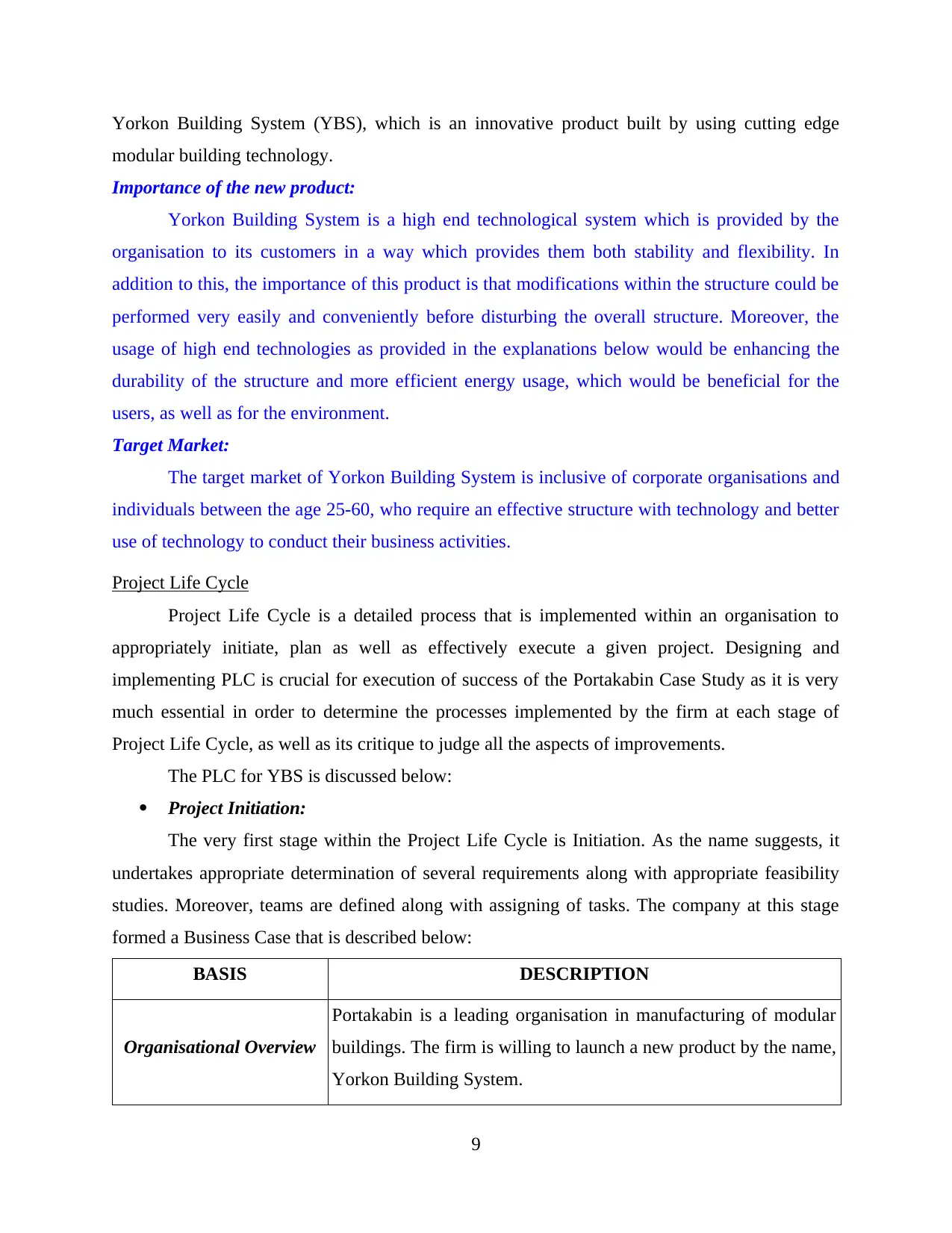
Yorkon Building System (YBS), which is an innovative product built by using cutting edge
modular building technology.
Importance of the new product:
Yorkon Building System is a high end technological system which is provided by the
organisation to its customers in a way which provides them both stability and flexibility. In
addition to this, the importance of this product is that modifications within the structure could be
performed very easily and conveniently before disturbing the overall structure. Moreover, the
usage of high end technologies as provided in the explanations below would be enhancing the
durability of the structure and more efficient energy usage, which would be beneficial for the
users, as well as for the environment.
Target Market:
The target market of Yorkon Building System is inclusive of corporate organisations and
individuals between the age 25-60, who require an effective structure with technology and better
use of technology to conduct their business activities.
Project Life Cycle
Project Life Cycle is a detailed process that is implemented within an organisation to
appropriately initiate, plan as well as effectively execute a given project. Designing and
implementing PLC is crucial for execution of success of the Portakabin Case Study as it is very
much essential in order to determine the processes implemented by the firm at each stage of
Project Life Cycle, as well as its critique to judge all the aspects of improvements.
The PLC for YBS is discussed below:
Project Initiation:
The very first stage within the Project Life Cycle is Initiation. As the name suggests, it
undertakes appropriate determination of several requirements along with appropriate feasibility
studies. Moreover, teams are defined along with assigning of tasks. The company at this stage
formed a Business Case that is described below:
BASIS DESCRIPTION
Organisational Overview
Portakabin is a leading organisation in manufacturing of modular
buildings. The firm is willing to launch a new product by the name,
Yorkon Building System.
9
modular building technology.
Importance of the new product:
Yorkon Building System is a high end technological system which is provided by the
organisation to its customers in a way which provides them both stability and flexibility. In
addition to this, the importance of this product is that modifications within the structure could be
performed very easily and conveniently before disturbing the overall structure. Moreover, the
usage of high end technologies as provided in the explanations below would be enhancing the
durability of the structure and more efficient energy usage, which would be beneficial for the
users, as well as for the environment.
Target Market:
The target market of Yorkon Building System is inclusive of corporate organisations and
individuals between the age 25-60, who require an effective structure with technology and better
use of technology to conduct their business activities.
Project Life Cycle
Project Life Cycle is a detailed process that is implemented within an organisation to
appropriately initiate, plan as well as effectively execute a given project. Designing and
implementing PLC is crucial for execution of success of the Portakabin Case Study as it is very
much essential in order to determine the processes implemented by the firm at each stage of
Project Life Cycle, as well as its critique to judge all the aspects of improvements.
The PLC for YBS is discussed below:
Project Initiation:
The very first stage within the Project Life Cycle is Initiation. As the name suggests, it
undertakes appropriate determination of several requirements along with appropriate feasibility
studies. Moreover, teams are defined along with assigning of tasks. The company at this stage
formed a Business Case that is described below:
BASIS DESCRIPTION
Organisational Overview
Portakabin is a leading organisation in manufacturing of modular
buildings. The firm is willing to launch a new product by the name,
Yorkon Building System.
9
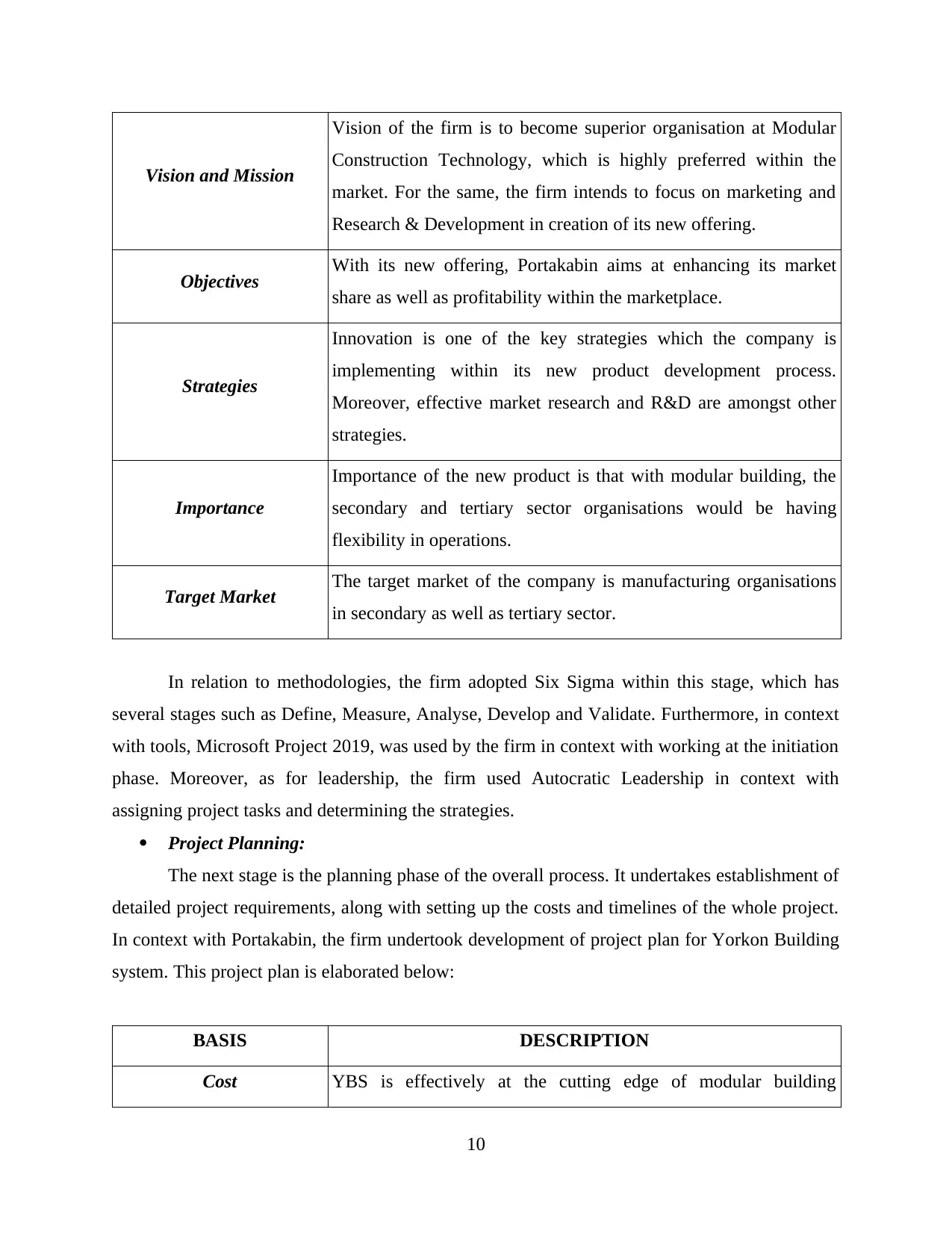
Vision and Mission
Vision of the firm is to become superior organisation at Modular
Construction Technology, which is highly preferred within the
market. For the same, the firm intends to focus on marketing and
Research & Development in creation of its new offering.
Objectives With its new offering, Portakabin aims at enhancing its market
share as well as profitability within the marketplace.
Strategies
Innovation is one of the key strategies which the company is
implementing within its new product development process.
Moreover, effective market research and R&D are amongst other
strategies.
Importance
Importance of the new product is that with modular building, the
secondary and tertiary sector organisations would be having
flexibility in operations.
Target Market The target market of the company is manufacturing organisations
in secondary as well as tertiary sector.
In relation to methodologies, the firm adopted Six Sigma within this stage, which has
several stages such as Define, Measure, Analyse, Develop and Validate. Furthermore, in context
with tools, Microsoft Project 2019, was used by the firm in context with working at the initiation
phase. Moreover, as for leadership, the firm used Autocratic Leadership in context with
assigning project tasks and determining the strategies.
Project Planning:
The next stage is the planning phase of the overall process. It undertakes establishment of
detailed project requirements, along with setting up the costs and timelines of the whole project.
In context with Portakabin, the firm undertook development of project plan for Yorkon Building
system. This project plan is elaborated below:
BASIS DESCRIPTION
Cost YBS is effectively at the cutting edge of modular building
10
Vision of the firm is to become superior organisation at Modular
Construction Technology, which is highly preferred within the
market. For the same, the firm intends to focus on marketing and
Research & Development in creation of its new offering.
Objectives With its new offering, Portakabin aims at enhancing its market
share as well as profitability within the marketplace.
Strategies
Innovation is one of the key strategies which the company is
implementing within its new product development process.
Moreover, effective market research and R&D are amongst other
strategies.
Importance
Importance of the new product is that with modular building, the
secondary and tertiary sector organisations would be having
flexibility in operations.
Target Market The target market of the company is manufacturing organisations
in secondary as well as tertiary sector.
In relation to methodologies, the firm adopted Six Sigma within this stage, which has
several stages such as Define, Measure, Analyse, Develop and Validate. Furthermore, in context
with tools, Microsoft Project 2019, was used by the firm in context with working at the initiation
phase. Moreover, as for leadership, the firm used Autocratic Leadership in context with
assigning project tasks and determining the strategies.
Project Planning:
The next stage is the planning phase of the overall process. It undertakes establishment of
detailed project requirements, along with setting up the costs and timelines of the whole project.
In context with Portakabin, the firm undertook development of project plan for Yorkon Building
system. This project plan is elaborated below:
BASIS DESCRIPTION
Cost YBS is effectively at the cutting edge of modular building
10
⊘ This is a preview!⊘
Do you want full access?
Subscribe today to unlock all pages.

Trusted by 1+ million students worldwide
1 out of 22
Related Documents
Your All-in-One AI-Powered Toolkit for Academic Success.
+13062052269
info@desklib.com
Available 24*7 on WhatsApp / Email
![[object Object]](/_next/static/media/star-bottom.7253800d.svg)
Unlock your academic potential
Copyright © 2020–2025 A2Z Services. All Rights Reserved. Developed and managed by ZUCOL.




